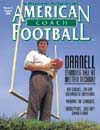Article CategoriesAFM Magazine
|
Prevent the Completion...Vandy\'s Man Coverage Techniquesby: Dino Folino Secondary Coach, Vanderbilt University © More from this issue Over the last several years, we have gained some national notoriety for our defensive play under the leadership of Coach Widenhofer. Playing in the SEC we have had to use a tough, aggressive defensive style to attempt to keep Florida, Tennessee, Kentucky, etc. from using their wide-open offenses to take us out of games. Most of our success at slowing down explosive passing games has come from our ability to play tight man coverage. The fundamental premise of our style of play is to prevent the completion. The following four questions must be answered with all man coverages: 1) How big is the split of the receiver? This will help the DB anticipate an inside or out route. 2) How deep has the quarterback dropped?
This gives the DB a time and distance relationship (refer to the chart). ....The full article can only be seen by subscribers.
|
|
|||||||
| HOME |
MAGAZINE |
SUBSCRIBE | ONLINE COLUMNISTS | COACHING VIDEOS |
Copyright 2025, AmericanFootballMonthly.com
All Rights Reserved





